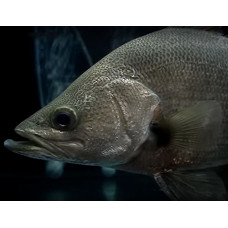Latin name
Lates niloticus
Other names
African snook, Goliath perch, African barramundi, Goliath barramundi, Giant lates, Victoria perch.
Identification
Body elongated, laterally compressed. Dorsal spines: 7-8; Dorsal soft rays: 8-14; Anal spines: 3; anal soft rays: 7-9. Mouth large and prominent, lower jaw slightly protruding. Numerous villous teeth on jaw, palate and scutellum. Scales crested, 54-74 along lateral line, followed by 6-8 spongy scales at base of caudal fin; ceratobranchial (lower extremity) of first gill arch with 12-14 gill shells.
Features of fish fins
Dorsal fin divided by a deep notch into anterior barb and posterior soft rays; anal fin with 3 spines. Caudal fin rounded.
Fish colouring
Body uniformly silvery or dark greyish-blue on the back, greyish- silver on the sides and abdomen. Fins are greyish; the inner part of the eye is conspicuously yellowish. Juveniles are brownish with lighter marbling on the head and flanks.
Distribution
Widespread in all major river systems of tropical Africa, particularly the Nile, Volta, Senegal and Congo rivers, and lakes such as Chad, Albert, Rudolph and Victoria.
Habitat
Freshwater, bottom-dwelling, potamodromous species. Depth range 10-60 m. Tropical, found from latitudes 27°N to 7°S. Occupies canals, lakes and irrigation canals. Adults in deep water, juveniles in shallow water.
Size
The maximum length is 200 cm and the maximum weight is 200 kg.
Behavior
Females will never abandon their young. At the slightest danger, the entire brood will hide in their mouths. When the young are no longer able to fit in there, they move to shallow water to live independently, feeding on shrimps and smaller inhabitants.
Food and feeding habits
Predatory fish that feeds on fish and crustaceans. Smaller fish also eat crustaceans and insects. Juveniles are plankton eaters.
Reproduction
Average life expectancy is around 16-20 years. Sexual maturity occurs from the age of three. Their mating season occurs when the water temperature becomes consistently warm.
Fishing
Sport fishing for this fish is popular. It has white, tender flesh with a faint odour.
Relationship with a person
Several countries report negative environmental impacts following the introduction of this species.
| Classification | |
| Phylum | Chordata |
| Class | Actinopterygii |
| Squad | Perciformes |
| Family | Latidae |
| Genus | Lates |
| Species | L. niloticus |
| Features | |
| Conservation status | Least Concern |
| Habitat | Bottom |
| Life span, years | 20 |
| Maximum body weight, kg | 200 |
| Maximum length, cm | 200 |
| Sailing speed, m/s | No information |
| Threat to people | Edible |
| Way of eating | Predator |
Nile perch
Tags: nile perch



